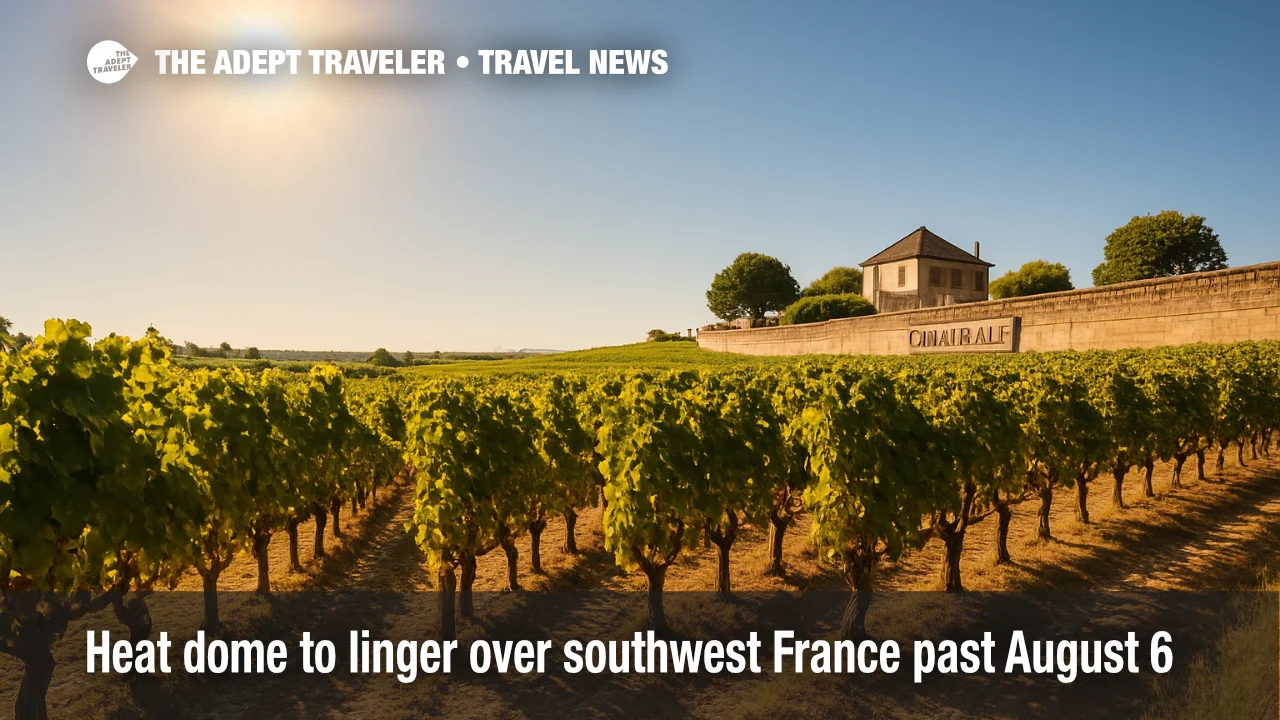Heat dome to linger over southwest France past August 6

A persistent high-pressure ridge will keep southwestern France under a heat dome into mid-August, fueling temperatures near 104 °F, elevated fire danger, and schedule tweaks at outdoor attractions. Travelers should plan for early-morning sightseeing, air-conditioned lodging, and wildfire-related detours across Nouvelle-Aquitaine and Occitanie.
Key Points
- Why it matters: Extreme heat raises health and wildfire risks for Bordeaux-Toulouse itineraries
- Météo-France tips 70 % odds of warmer-than-usual weather through August 24
- La Chaîne Météo warns of a fresh surge of "very hot and humid" air after August 11
- Wildfire danger is "severe" in Landes and Gers; forest trails may close on red-alert days
- River-cruise lines on the Garonne are shifting excursions to dawn and dusk slots
Snapshot
Southwestern France has already endured two heatwaves this summer, peaking at 41 °C (106 °F) in late June. Forecast models show the subtropical ridge rebuilding during the week of August 4-10, followed by another warm pulse around August 11-17. Daytime highs of 38-42 °C are most likely between the Gironde estuary and the Tarn Valley, while overnight lows may stay above 23 °C, limiting natural cooling. Authorities are pre-positioning additional firefighting crews after early-season blazes scorched 400 ha near Mont-de-Marsan. Travelers will find rail and aviation operations mostly normal, but afternoon track-speed restrictions and aircraft weight limits are possible on the hottest days.
Background
France's 50th national heatwave since 1947 ran from June 19 to July 4, driven by an Omega block that parked a heat dome over Western Europe. That event closed 1 350 schools and the Eiffel Tower's summit. Although a brief Atlantic trough brought seasonal temperatures in late July, Météo-France's June-August outlook favors above-normal warmth, reflecting a climate-change-amplified trend: six of the country's ten longest heatwaves have occurred since 2015. Soil-moisture deficits now exceed 25 % of normal in the Landes forest, heightening ignition potential.
Latest Developments
Anticyclone to re-strengthen August 4-10
La Chaîne Météo's four-week outlook expects a south-building high to deliver "calm, sunny weather" nationwide, with southwestern highs "slightly above normal" by August 8. Evening pop-up storms remain limited to the Pyrenees foothills.
Second heat pulse August 11-17
The same outlook flags "possibly strong heat south of the Loire," a scenario echoed by ECMWF ensemble runs showing a +3 °C anomaly core over Nouvelle-Aquitaine. Regional prefects may reactivate orange heat alerts, triggering cooling-center openings and farm-work hour limits.
Travel industry responses
River-cruise operators are adjusting shore tours to start before 9 a.m. or after 7 p.m. Bordeaux's Cité du Vin will cap rooftop-deck access above 95 °F, while Toulouse's Aeroscopia Museum plans misting stations on its outdoor aircraft ramp. Tour guides now carry electrolyte sachets and enforce 15-minute hydration breaks.
Analysis
A lingering heat dome poses three main risks to travelers. Health: Prolonged exposure to 100 °F-plus heat elevates dehydration and heat-stroke odds within 30 minutes of strenuous walking. U.S. visitors, unfamiliar with France's limited public-space air-conditioning, should secure accommodation with verified A/C and schedule siesta-style breaks. Wildfire: Landes, Lot-et-Garonne, and Haute-Garonne sit under "très élevé" fire indices. Road or rail closures can occur with little warning when smoke crosses the A63 or Bordeaux-Toulouse TGV line, so flexible tickets and extra rental-car insurance are prudent. Infrastructure stress: SNCF imposes 20-mph speed cuts when rail temperatures exceed 122 °F, lengthening trips by up to 40 minutes. Airports such as Bordeaux-Mérignac may delay afternoon departures to shed payload under hot-and-high density-altitude rules. Combining these factors, the heat dome demands meticulous itinerary padding: plan early starts, indoor cultural venues from 2-6 p.m., and refundable reservations for outdoor wine-estate visits. With appropriate heat management and wildfire awareness, travel remains feasible, but July's disruptions show how quickly conditions can pivot under a stationary ridge.
Final Thoughts
Southwestern France's post-August 6 heat dome reinforces the region's new climate reality: longer, hotter summers with elevated wildfire threats. Travelers who embrace early-morning touring, air-conditioned lodging, and flexible routing can still savor Bordeaux's vineyards and Toulouse's pink-brick charm-while respecting local heat-alert protocols. Smart planning turns a challenging forecast into a safe, memorable journey through heat-domed southwest France.
Sources
- Heat Dome brings the most intense heatwave of the year into western Europe; France up to +43 °C next week - Severe Weather Europe
- Tendance météo à 4 semaines : vers un temps de saison avant le retour de la chaleur - La Chaîne Météo
- Tendances pour juin, juillet et août 2025 - Météo-France
- Heatwave across the Med sparks health and fire warnings - France 24
- What is a 'heat dome' and how does it power heatwaves? - Reuters
- Heat Wave in Europe: What Every Traveler Needs to Know - Kiplinger
- Forest fires in France begin amid heatwave: 400 ha burned - The Connexion
